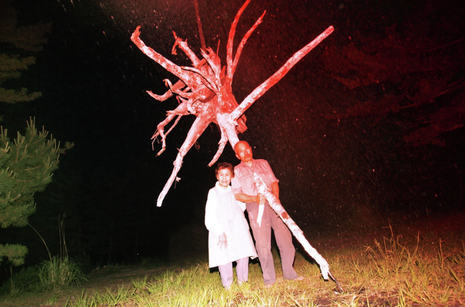Fukushima through the lens: ‘Picturing the Invisible’ at the Heong Gallery
Tomos Davies reviews the latest exhibition at the Heong Gallery, finding it to be a poignant exploration of tragedy through innovative photography

On 11 March 2011, a magnitude 9 earthquake caused the destructive tsunami which resulted in three core meltdowns at the Fukushima Daiichi Nuclear Power Plant. The cumulative effects of these crises claimed in excess of 16,000 lives, while the nuclear accident alone forced the evacuation of some 154,000 people. It is this event – known colloquially as “3.11” – which is the subject of “Picturing the Invisible”, the latest show at the Heong Gallery. As experimental as it is poignant, this exhibition interrogates the act of remembrance by pushing the boundaries of beauty and exploring fresh applications of technology, harnessing the power of photography to memorialise the disaster.
Curator Dr Makoto Takahashi brings together the work of nine multi-award-winning photographers, displaying each image alongside an accompanying essay. In bridging visual art and the written word, Takahashi juxtaposes creative expression with academic rationality. Far from being stifled by sterile intellectualism, the exhibits are enriched by the insight and analysis of some of the world’s leading policy-makers, researchers and activists.
“The exhibition balances sensitivity with innovation”
As with all photography, light and its manipulation lies at the very heart of each exhibit. Yet here, the viewer is invited to see the unseen. To make this possible, artists such as Yoi Kawakubo, Giles Price and Takashi Arai employ a variety of techniques, revealing for our eyes the malignant radiation which lingers in Fukushima to this day. Be it the disquieting glow of radioactive footprints or the spectral abstracts of contaminated topsoil, these images capture the natural consequences of man-made disaster.
Kawakubo’s are, for me, the most compelling images of the exhibition. His series, “If the radiance of a thousand suns were to burst in the skies at once”, saw him bury silver halide film in the earth around Fukushima’s exclusion zone. The resulting photographs are iridescent reminders of the dangers of nuclear energy, printed at monumental scale to command attention and emphasise their visual draw. These are unnervingly beautiful artworks. As viewers, we are tasked with decoding the images before reflecting on our own reaction. Given the sombre subject matter, I found myself struggling to reconcile their undeniable aesthetic allure: a testament to the artist’s success in promoting a deeper level of engagement.
“In this age of media bombardment and sensory overload, Takahashi’s curation is a refreshing take on tragedy”
For the Heong Gallery, “Picturing the Invisible” marks something of a departure from the playful compositions of “Hockney’s Eye”. You’d be forgiven for thinking that the serene environment of neoclassical Downing College was an unnatural choice for the dystopian photographs of Takahashi’s collection. But that shouldn’t put you off. If anything, this juxtaposition complements the tension between beauty and melancholy which proves to be such a recurrent theme.
Given the significance of its central subject, the exhibition does occasionally lose focus. Particularly where works pre-date 3.11, I wasn’t entirely convinced of their relevance to the events of Fukushima. However, these are the minority, and the accompanying essays do a worthy job plugging any gaps for the viewer.
Described as “the most severe crisis that Japan has faced since World War II”, the legacy of Fukushima remains fresh. As a reaction to this collective memory, the exhibition balances sensitivity with innovation, handling its source material with compassion while steadfast in its determination to challenge artistic norms. The result is a series of images which feel tragically timeless. Though they are snapshots of the past, these photographs remain pertinent. An indelible stain on the Japanese landscape, the fallout of radiation continues to shape public discourse. Debates over the attribution of blame are unresolved, a theme which is explored to great effect by a number of the exhibits.
“Picturing the Invisible” is a demanding exhibition, requiring viewers to interact with the artwork and embrace the subtleties of their meaning. Nevertheless, it is a relentlessly engaging show, remarkably diverse given its small scale, and with a relevance that defies its geographic specificity. To be honest, I came to the gallery with little prior knowledge of Fukushima. Yet my interest was immediately piqued. Accessible to the non-specialist, the show is well worth a visit, and visitors should take the time to digest the photographs alongside their companion essays. Emotive photography need not be gory. In this age of media bombardment and sensory overload, Takahashi’s curation is a refreshing take on tragedy and a cathartic exposition that marries technical execution with thoughtful commentary.
On the third leg of its acclaimed world tour, “Picturing the Invisible” is at the Heong Gallery until 23 April, open Wednesday–Sunday 12–5.
 Comment / Plastic pubs: the problem with Cambridge alehouses 5 January 2026
Comment / Plastic pubs: the problem with Cambridge alehouses 5 January 2026 News / Cambridge businesses concerned infrastructure delays will hurt growth5 January 2026
News / Cambridge businesses concerned infrastructure delays will hurt growth5 January 2026 News / New movement ‘Cambridge is Chopped’ launched to fight against hate crime7 January 2026
News / New movement ‘Cambridge is Chopped’ launched to fight against hate crime7 January 2026 News / AstraZeneca sues for £32 million over faulty construction at Cambridge Campus31 December 2025
News / AstraZeneca sues for £32 million over faulty construction at Cambridge Campus31 December 2025 Interviews / You don’t need to peak at Cambridge, says Robin Harding31 December 2025
Interviews / You don’t need to peak at Cambridge, says Robin Harding31 December 2025










